Every kitchen has its magic moments. Creating the perfect caesar salad is one of them. It turns an ordinary meal into something special. Imagine that first crisp bite of romaine lettuce, perfectly dressed with a creamy, robust dressing.
A beautifully arranged Caesar salad preparation scene featuring fresh romaine lettuce, crispy croutons, grated Parmesan cheese, and a drizzle of creamy Caesar dressing. The background shows a wooden cutting board with ingredients like garlic, lemon wedges, and anchovies, all surrounded by vibrant greens and kitchen utensils, creating a fresh and inviting culinary atmosphere. The lighting is warm and natural, emphasizing the freshness of the ingredients.
The caesar salad is more than just a dish. It’s a celebration of simple ingredients coming together in perfect harmony. Whether you’re a home cook or aspiring chef, mastering this classic recipe will make your dining experience amazing. Your journey into creating restaurant-quality caesar salad starts right here.
This salad has captivated food lovers worldwide. It blends crisp romaine lettuce with a legendary dressing. This dressing promises complexity and satisfaction in every forkful. Learning to craft an authentic caesar salad will become your secret weapon in impressive meal preparation.
Key Takeaways
- Discover the art of creating a perfect caesar salad
- Learn how simple ingredients can transform your cooking
- Understand the balance of flavors in classic dressing
- Explore techniques for restaurant-quality results at home
- Gain confidence in preparing a versatile, crowd-pleasing dish
The Rich History Behind Caesar Salad
The caesar salad is more than just a simple dish. It’s a story with roots in Mexican cuisine. This salad has traveled from a small restaurant in Tijuana to tables all over the world.
A rustic Italian kitchen setting featuring a classic Caesar salad with romaine lettuce, croutons, and parmesan cheese, surrounded by historical artifacts like an old wooden table, a vintage olive oil bottle, and a bowl of freshly cracked black pepper, soft natural lighting highlighting the vibrant greens and textures of the salad.
Caesar Cardini, an Italian-American restaurateur, created the salad in 1924. It was during a Fourth of July rush at his Tijuana restaurant. With limited ingredients, Cardini made a salad that would become famous.
Origins in Tijuana, Mexico
Cardini’s original caesar salad was made right at the table. It turned simple ingredients into something amazing. The main parts were:
- Whole romaine lettuce leaves
- Garlic-infused croutons
- Parmesan cheese
- Raw egg
- Olive oil
Evolution Into a Global Classic
The salad quickly became popular in the United States and then around the world. Restaurants started adding their own twist. Anchovies became a hot topic, loved by some but not by others.
Traditional vs Modern Interpretations
| Traditional Caesar Salad | Modern Variations |
|---|---|
| Whole lettuce leaves | Chopped romaine |
| Raw egg dressing | Cooked or eggless dressing |
| Optional anchovies | Anchovies as standard ingredient |
Today, chefs around the world are making their own versions of the caesar salad. They keep the classic taste while adding their own twist.
Essential Ingredients for an Authentic Caesar Salad
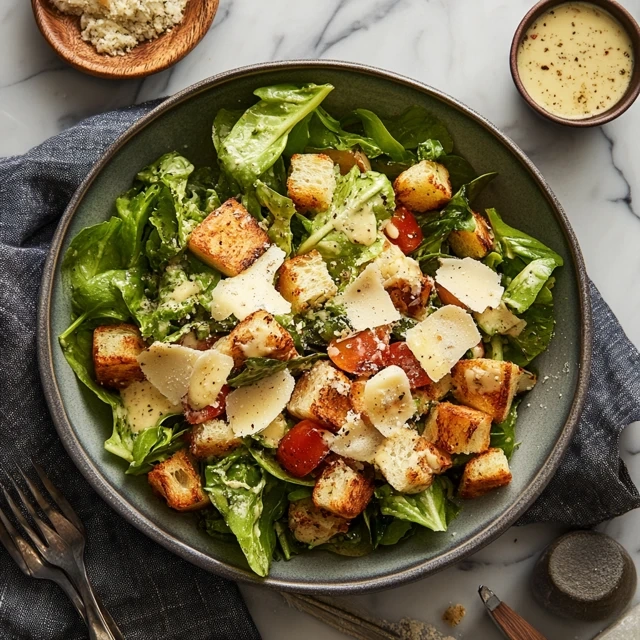
A top-down view of a vibrant Caesar salad spread on a rustic wooden table, featuring crisp romaine lettuce, freshly grated Parmesan cheese, crunchy croutons, a small bowl of creamy Caesar dressing, and scattered black pepper. Lightly drizzled olive oil glistens on the ingredients, with a few lemon wedges placed artistically around the salad. Natural sunlight casts soft shadows, enhancing the freshness and colors of the ingredients.
To make a real Caesar salad, you need top-notch ingredients. They must work together for a taste that’s unforgettable. Start by knowing the key parts that make this salad stand out.
Here are the must-haves:
- Romaine Lettuce: The crisp base of your Caesar salad
- Freshly grated parmesan cheese for a rich, nutty taste
- Homemade croutons for a satisfying crunch
- Caesar dressing that’s tangy and creamy
Your parmesan cheese should be of high quality and freshly grated. Real Parmigiano-Reggiano has a flavor that pre-packaged cheese can’t match. Choose a wedge with a hard, granular texture that grates well.
Croutons are key in your Caesar salad. While you can buy them, making your own is better. Use a sturdy bread like sourdough or French bread, cut into cubes. Then, toast them until they’re golden and crispy.
The caesar dressing is the salad’s heart. Traditional recipes use raw egg yolks, garlic, lemon juice, olive oil, and anchovies. Each adds a special flavor that turns simple ingredients into a masterpiece.
Mastering the Perfect Caesar Dressing
Making a great caesar dressing takes skill and knowing the right ingredients. It’s all about mixing anchovies, garlic, and other classic parts just right. This creates a creamy, tasty sauce that makes your salad better.
Balancing Flavors with Anchovies and Garlic
Anchovies are the key to a real caesar dressing. They add a deep umami flavor that makes the dressing stand out. Choose high-quality anchovies in olive oil for the best taste.
- Use 2-3 anchovy fillets per serving
- Mince garlic finely to distribute flavor evenly
- Select fresh garlic cloves for maximum punch
Emulsion Techniques for Creamy Texture
To get a smooth caesar dressing, you need to master emulsion techniques. Whisking olive oil into egg yolks slowly makes a silky base. This keeps the dressing from separating.
| Technique | Key Steps |
|---|---|
| Hand Whisking | Drizzle oil gradually while constantly mixing |
| Blender Method | Blend ingredients at low speed for consistent texture |
Make-Ahead Tips and Storage
You can make your caesar dressing ahead of time. Keep it in an airtight container in the fridge for up to 5 days. This lets the flavors get stronger.
- Refrigerate immediately after preparation
- Stir well before serving
- Avoid freezing to maintain texture
Selecting and Preparing Fresh Romaine Lettuce
Choosing the perfect romaine lettuce is key for a great Caesar salad. You want crisp, vibrant romaine hearts for the best crunch and flavor.
When shopping for romaine lettuce, look for these key characteristics:
- Bright green leaves with no browning or wilting
- Firm, compact hearts with minimal blemishes
- Fresh, clean appearance without signs of decay
- Compact and heavy for their size
Proper cleaning and preparation are essential for a salad masterpiece. Follow these expert tips to ensure your lettuce is pristine and ready for dressing:
- Rinse romaine lettuce under cool running water
- Gently separate leaves to remove dirt and debris
- Pat dry thoroughly with clean kitchen towels
- Chill lettuce for extra crispness before serving
To maximize the flavor and texture of your romaine lettuce, consider these cutting techniques:
| Cutting Method | Best Used For |
|---|---|
| Chopped | Classic Caesar salad presentation |
| Torn | Rustic, informal dining |
| Whole leaves | Elegant, traditional serving style |
By selecting premium romaine lettuce and preparing it with care, you’ll elevate your Caesar salad. The right lettuce makes all the difference in creating a memorable culinary experience.
Crafting Homemade Garlic Croutons
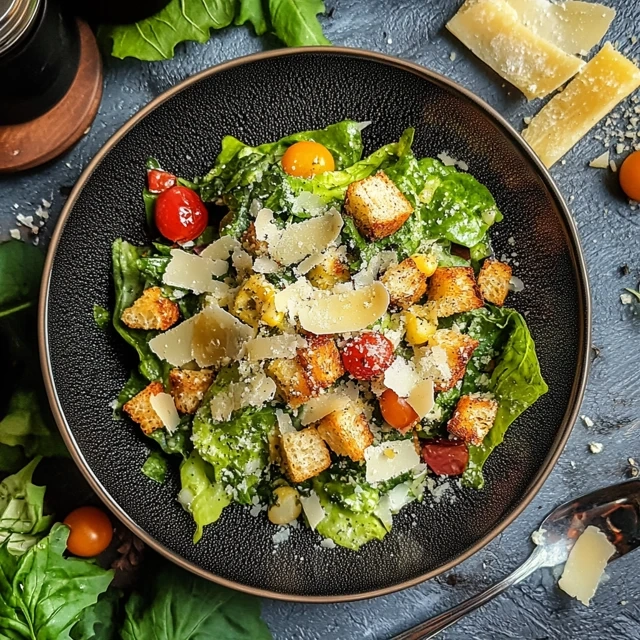
Make your Caesar salad better with homemade croutons. They add a crispy, flavorful touch to every bite. The key is to pick the right bread and learn how to prepare it.
Choosing the Right Bread
Not all bread is good for croutons. Choose day-old artisan or sourdough bread. It’s staler, the better it is for making crispy garlic croutons.
- Sourdough
- French baguette
- Ciabatta
- Rustic white bread
Seasoning Your Croutons
Garlic makes regular bread cubes into tasty croutons. Use fresh garlic for the best taste. Mix bread cubes with olive oil, minced garlic, salt, and herbs like oregano or parsley.
Baking Techniques
To get golden, crunchy croutons, bake at 375°F for 10-12 minutes. Place cubes on a baking sheet in a single layer. This ensures they toast evenly. Stir them now and then to avoid burning.
Storage Solutions
Keep homemade garlic croutons in an airtight container at room temperature. They stay fresh for up to a week. Use them to top salads and soups.
The Art of Choosing and Grating Parmesan Cheese
Choosing the right parmesan cheese can make your Caesar salad amazing. Real Parmigiano-Reggiano adds a rich, nutty taste that makes the salad better. It’s important to know how to pick and prepare it.
Identifying Quality Parmesan Cheese
- Look for Parmigiano-Reggiano from Italy
- Check for the official stamp of authenticity
- Opt for wedges over pre-grated cheese
- Seek cheese aged 24-36 months for optimal flavor
The age of parmesan cheese changes its taste. Younger cheese is milder and creamier. Older cheese is sharper and adds a rich texture to your Caesar salad.
Grating Techniques
Grating fresh parmesan releases its strongest flavors. Use a microplane or fine grater to get thin, fluffy shavings. These will cover your salad greens beautifully.
| Cheese Age | Flavor Profile | Recommended Use |
|---|---|---|
| 12-18 months | Mild and smooth | Light garnishing |
| 24-36 months | Sharp and complex | Intense Caesar salad topping |
| 36+ months | Extremely intense | Sparingly used as accent |
Pro tip: Store your parmesan cheese in the refrigerator’s vegetable drawer. Wrap it in wax paper to keep it fresh and prevent moisture.
Tips for Assembly and Presentation
Making the perfect caesar salad is more than just mixing ingredients. Your presentation can turn a simple dish into a feast for the eyes and taste buds.
Layering Techniques for Maximum Flavor
Start with crisp romaine lettuce as the base. Make sure each leaf is clean and dry. Use these tips to add height and texture:
- Tear romaine lettuce into bite-sized pieces instead of chopping
- Layer ingredients from heaviest to lightest
- Alternate between greens and toppings for visual appeal
Plating Suggestions That Impress
Your caesar salad can look either rustic or elegant. Here are some ways to serve it:
- Individual plated servings with neatly arranged ingredients
- Large shared platters for communal dining
- Deconstructed caesar salad for a modern twist
Creative Garnishing Ideas
Add garnishes that make your salad look great and taste even better. Try these ideas:
- Sprinkle freshly grated Parmesan
- Add crispy homemade croutons
- Garnish with delicate herb leaves
Common Mistakes to Avoid When Making Caesar Salad
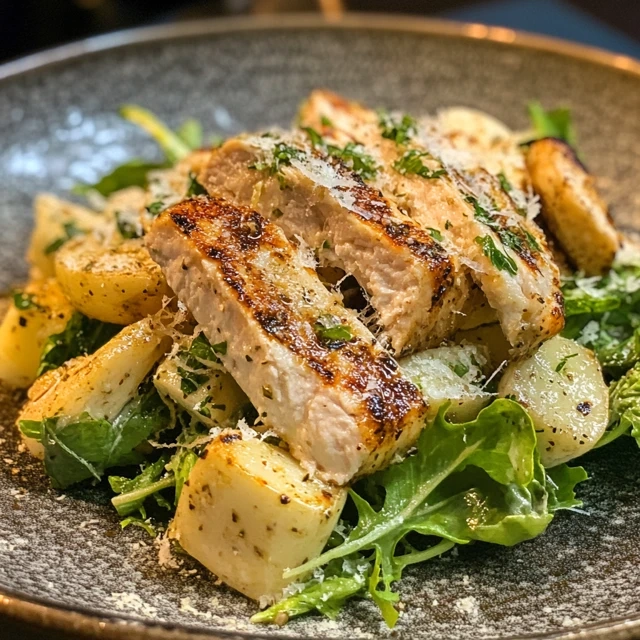
Making a perfect Caesar salad needs careful attention. Many home cooks make mistakes that ruin a dish. Knowing these common errors can improve your salad and dressing skills.
Common mistakes can ruin your Caesar salad. Here are the main errors to avoid:
- Overdressing the Salad: Too much caesar dressing can mess up the flavors. Add it lightly.
- Soggy or Stale Croutons: Croutons should be crunchy. Don’t use old or packaged bread.
- Improperly Emulsified Dressing: A bad caesar dressing can ruin the salad’s texture and taste.
How you prepare your lettuce is key. Always dry romaine leaves well. Wet lettuce makes the dressing watery and unappetizing.
Choosing the right cheese is also important. Pre-grated Parmesan loses its flavor. Use freshly grated cheese for better taste and texture.
- Avoid using low-quality ingredients
- Always taste and adjust seasoning
- Prepare croutons just before serving
By mastering these techniques, your homemade Caesar salad will be amazing. You’ll enjoy a top-notch meal in your own kitchen.
Dietary Modifications and Substitutions
Making a versatile caesar salad for different diets doesn’t mean losing flavor. You can enjoy this classic dish even if you’re vegetarian, gluten-sensitive, or watching calories.
Vegetarian Flavor Solutions
It’s easy to replace anchovies in your caesar salad. Try these umami-rich options:
- Capers for briny flavor
- Miso paste for depth
- Nutritional yeast for cheesy undertones
For a Worcestershire sauce substitute, choose vegetarian versions. Look for ones made with tamari or soy sauce to keep the caesar salad’s signature taste.
Gluten-Free Adaptations
Gluten-free diners can still enjoy a tasty caesar salad with a few swaps:
- Use gluten-free bread for croutons
- Check Worcestershire sauce labels for gluten-free certification
- Verify parmesan cheese is rennet-free
Lower-Calorie Strategies
Make your caesar salad lighter without losing its classic taste:
- Replace traditional dressing with Greek yogurt base
- Bake croutons instead of frying
- Use a smaller portion of cheese
- Add more fresh romaine for volume
With these changes, your caesar salad can be a dish everyone can enjoy.
Conclusion
Making the perfect caesar salad is an art. It combines technique, quality ingredients, and passion. You’ve learned how to pick crisp romaine lettuce and mix a smooth dressing with lemon juice.
This knowledge lets you turn a simple salad into a dish fit for a restaurant. You now know how to balance flavors, especially the tangy Dijon mustard. Each part, from homemade croutons to Parmesan and dressing, adds to the taste and texture.
Mastering a caesar salad means respecting tradition but also adding your own twist. Whether you stick to the classic or try new things, you can impress everyone. Your skills will make your salads unforgettable.
Keep exploring in the kitchen and let your caesar salad show off your growing talents. With time and effort, you’ll make salads that rival those of chefs.
Free Body Calculator – Know Your Body
Wondering if your body is in a healthy range? Use our Free Body Calculator to find out if you’re fit, normal, or need a lifestyle change. Get personalized tips, calorie targets, and your ideal protein, carbs, and fat intake – all in seconds.
Try Free Body Calculator Now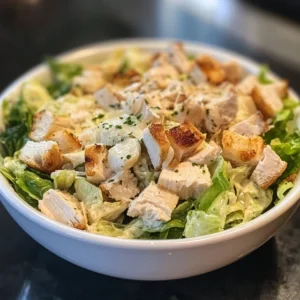
Easy Caesar Salad with Homemade Dressing and Croutons
Ingredients
- For the Salad:
- 1 large head of romaine lettuce chopped
- 1 cup croutons homemade or store-bought
- ½ cup Parmesan cheese grated or shaved
- For the Caesar Dressing:
- ½ cup mayonnaise or Greek yogurt for a lighter option
- 2 tbsp Parmesan cheese grated
- 2 tbsp lemon juice freshly squeezed
- 1 tsp Dijon mustard
- 1 tsp Worcestershire sauce
- 1 clove garlic minced
- ½ tsp black pepper
- ¼ tsp salt
- 2 tbsp olive oil
Instructions
- Make the Dressing:
- In a small bowl, whisk together mayonnaise, Parmesan cheese, lemon juice, Dijon mustard, Worcestershire sauce, garlic, salt, and black pepper.
- Slowly drizzle in the olive oil, whisking continuously until smooth and creamy.
- Assemble the Salad:
- In a large bowl, toss the chopped romaine lettuce with the dressing until evenly coated.
- Add the croutons and grated Parmesan cheese, then toss lightly.
- Serve And Enjoy:
- Garnish with extra Parmesan and freshly ground black pepper. Serve immediately.
Notes
- Add Protein: Top with grilled chicken, shrimp, or salmon.
- Make It Healthier: Use Greek yogurt instead of mayo and whole-wheat croutons.
- Make It Ahead: Store undressed salad and dressing separately for up to 2 days.
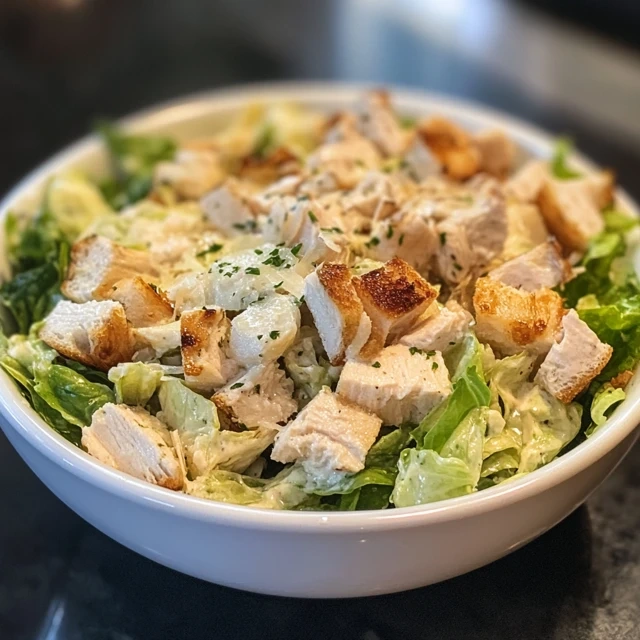

3 thoughts on “Easy Caesar Salad with Homemade Dressing and Croutons”
Comments are closed.